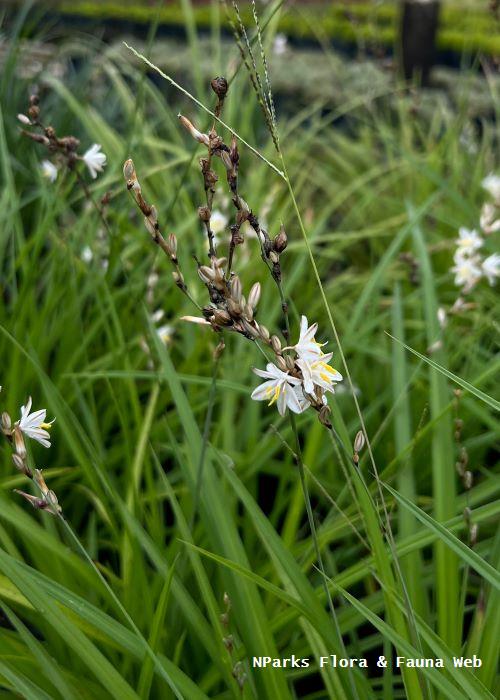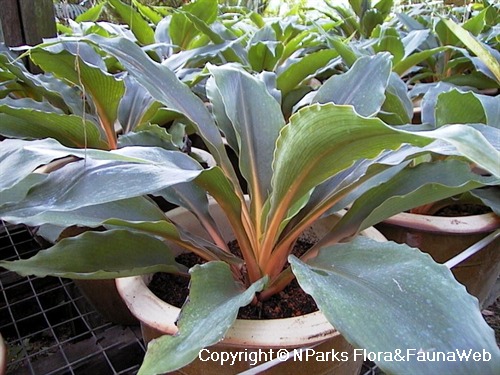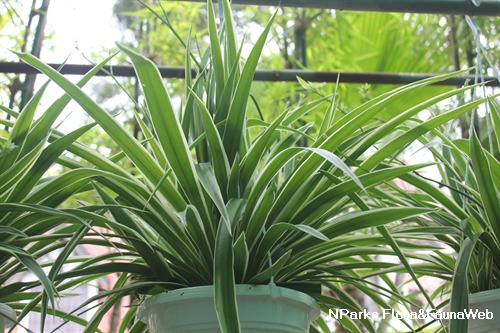
Back
Chlorophytum saundersiae (Baker) Nordal
| Family Name: | Asparagaceae |
| Synonyms: | Anthericum saundersiae Baker, Anthericum pulchellum Baker, Anthericum rudatisii Poelln. |
| Common Name: | Weeping Anthericum |
The Weeping Anthericum (Chlorophytum saundersiae) is a perennial herb related to the Spider Plant (C. comosum). It has thin, weepy, strap-like leaves, and small, white, star-shaped flowers. The species is best planted in mass planting, creating a meadow-like appearance.
Name
Classifications and Characteristics
| Plant Division | Angiosperms (Flowering Seed Plants) (Monocotyledon) |
|---|---|
| Plant Growth Form | Herbaceous Plant |
| Lifespan (in Singapore) | Perennial |
| Mode of Nutrition | Autotrophic |
| Plant Shape | Grassy |
| Maximum Height | 40 cm |
Biogeography
| Native Distribution | Eastern South Africa, KwaZulu-Natal, and Eswatini (formerly Swaziland) |
|---|---|
| Native Habitat | Terrestrial (Coastal Forest, Grassland / Savannah/ Scrubland) |
| Preferred Climate Zone | Tropical, Sub-Tropical / Monsoonal |
| Local Conservation Status | Non-native (Horticultural / Cultivated Only) |
Description and Ethnobotany
| Growth Form | It is a perennial, herbaceous plant that forms clumps up to 40 cm tall. It has a rosetted, grass-like appearance. |
|---|---|
| Foliage | The leaves are light green, thin, and linear, reaching 30-40 cm long and 1 cm wide. They are arranged in a basal rosette. |
| Flowers | The inflorescence is a long, drooping raceme with a cluster of flowers along the stem. The flowers are white and star-shaped, with each of the six tepals (petals and sepals that resemble one another) reaching up to 1 cm long. The flowers will bloom in the morning and close by noon. |
| Fruit | The fruit is a small capsule (a type of dry, dehiscent fruit) that ripens from green to brown. Upon maturity, the fruit breaks open to release several black, angled seeds. |
| Habitat | It can be found in coastal forest floors and low grasslands near river mouths, which become inundated at times. |
| Cultivation | It grows best in bright, direct sunlight or partial shade. Although it can tolerate a wide range of soil, it prefers sandy soil with lots of compost. It is relatively low-maintenance, fast-growing, and pest-resistant. |
| Etymology | The genus Chlorophytum comes from the Greek words chloros "green", and phyton "plant". The specific epithet saundersiae is named in honour of Katharine Saunders, a well-known British plant collector and artist from the 19th century. |
Landscaping Features
| Landscaping | This species looks best in mass plantings, creating a meadow-like appearance. |
|---|---|
| Desirable Plant Features | Ornamental Form, Ornamental Flowers |
| Landscape Uses | Coastal, Container Planting, Flowerbed / Border, Groundcover, General, Parks & Gardens |
| Thematic Landscaping | Wildflower Garden, Bioswales / Sunken Garden, Zen / Minimalist Garden |
Fauna, Pollination and Dispersal
| Pollination Method(s) | Biotic (Fauna) (Insects (Bee), Insects (Butterfly, Moth)) |
|---|---|
| Seed or Spore Dispersal | Abiotic (Explosive Dehiscence, Wind) |
Plant Care and Propagation
| Light Preference | Full Sun, Semi-Shade |
|---|---|
| Water Preference | Moderate Water |
| Plant Growth Rate | Fast to Moderate |
| Rootzone Tolerance | Easy to Grow, Well-Drained Soils, Fertile Loamy Soils |
| Maintenance Requirements | Low |
| Propagation Method | Division, Seed |
Foliar
| Foliage Retention | Evergreen |
|---|---|
| Mature Foliage Colour(s) | Green - Light Green |
| Mature Foliage Texture(s) | Smooth |
| Foliar Type | Simple / Unifoliate |
| Foliar Arrangement Along Stem | Basal, Rosulate / Rosette |
| Foliar Attachment to Stem | Sessile |
| Foliar Shape(s) | Non-Palm Foliage (Linear) |
| Foliar Venation | Parallel |
| Foliar Margin | Entire |
| Foliar Apex - Tip | Acuminate |
| Foliar Base | Truncate / Square |
| Typical Foliar Size | 30 cm to 40 cm |
Non - Foliar and Storage
| Root Type | Underground (Fibrous Root) |
|---|
Floral (Angiosperm)
| Flower & Plant Sexuality | Bisexual Flowers |
| Flower Colour(s) | White |
|---|---|
| Flower Grouping | Cluster / Inflorescence |
| Flower Location | Terminal |
| Flower Symmetry | Radial |
| Individual Flower Shape | Stellate / Star-shaped |
| Inflorescence Type | Raceme |
| Ovary Position | Superior / Hypogynous |
| Flowering Opening Time | Daytime |
| Flower Lifespan on Plant | 1 day |
| Flowering Habit | Polycarpic |
Fruit, Seed and Spore
| Mature Fruit Colour(s) | Brown |
|---|---|
| Fruit Classification | Simple Fruit |
| Fruit Type | Dehiscent Dry Fruit , Capsule |
| Mature Seed Colour(s) | Black |
| Seed Quantity Per Fruit | Several (11-20) |
References
| References | Obermeyer, A.A. (1962). A revision of the South African species of Anthericum, Chlorophytum and Trachyandra. 669-767. Johannsmeier, A. Chlorophytum saundersiae. https://pza.sanbi.org/chlorophytum-saundersiae. Accessed 3 Jan. 2025.
|
|---|
Image Repository
Others
| Master ID | 34384 |
|---|---|
| Species ID | 8797 |
| Flora Disclaimer | The information in this website has been compiled from reliable sources, such as reference works on medicinal plants. It is not a substitute for medical advice or treatment and NParks does not purport to provide any medical advice. Readers should always consult his/her physician before using or consuming a plant for medicinal purposes. |







